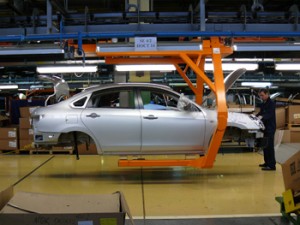 Russian OEM Avtovaz is understood to be considering ways in which to expand the supply of its vehicles to China, after Kazakhstan’s Asia Avto began regular exports of Lada 4x4s to the country recently from its plant in Ust-Kamenogorsk, in the East Kazakhstan region.
Russian OEM Avtovaz is understood to be considering ways in which to expand the supply of its vehicles to China, after Kazakhstan’s Asia Avto began regular exports of Lada 4x4s to the country recently from its plant in Ust-Kamenogorsk, in the East Kazakhstan region.
It is the first time any finished vehicles have been exported from Kazakhstan to China and also the first time Avtovaz cars have ever been supplied there.
Yerik Sagymbayev, president of Asia Avto, said the company had made several pilot deliveries of vehicles to China in January using various hauliers, but had shifted to rail for its new, regular supplies because of the more attractive costs.
He described the Chinese market as a difficult one to enter, suggesting that the logistics costs and customs duties involved would account for roughly 65% of the end price of a vehicle there.
He also said, however, that Asia Avto had already managed to sell its first 100 cars in China – hence the shift to regular supplies.
Sagymbayev indicated that Asia Avto planned to export up to 800 finished vehicles to China during the second quarter of this year and a total of 3,500 before the end of the year.
The governor of Samara Oblast, Nikolay Merkushin, has since confirmed that Avtovaz now plans to export finished vehicles to China from Russia, too. Merkushin said the Samar Oblast region, where Avtovaz has its main production assets, could export up to 10,000 vehicles a year to the Chinese market, adding that negotiations over such a supply were scheduled in coming weeks.
Neither Avtovaz nor Asia Avto would go into more detail about their plans, however.
According to Russia’s Federal Customs Service, Russia exported 4,100 light passenger vehicles to China and Taiwan last year – more than twice the level achieved in 2015.
Mikhail Burmistrov, head of Russian consultancy Infoline-Analyst, suggested that, while import duties for 4x4 models in China had fallen, the main problem in exporting to the country was still the legislative requirement to adapt models for the Chinese market in various ways.
Starting last year, Russia’s government began subsidising such modifications for export vehicles which had significantly improved the viability of exports, he said. But the effects of this had largely been negated by a strengthening rouble, he added.
Russian automotive analyst Maxim Kiselev agreed state aid was helping to support Russian exports to China but questioned the logistics costs involved in Avtovaz exporting from Russia to China, given that Asia Avto’s plant in Ust-Kamonogorsk was only 500-600km from the Chinese border while vehicles from Samara Oblast in Russia would need to cover more than 1,000km to the Black Sea ports, before being shipped on to China.


























![Global[1]](https://d3n5uof8vony13.cloudfront.net/Pictures/web/a/d/s/global1_726550.svgz)









